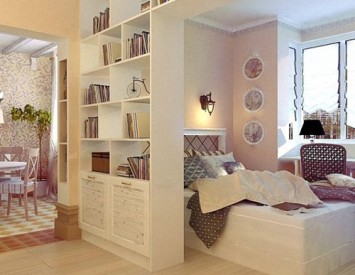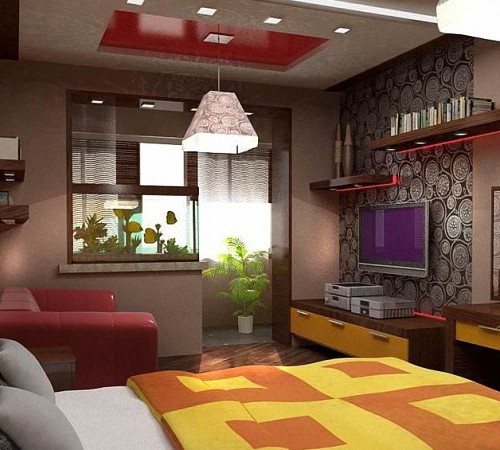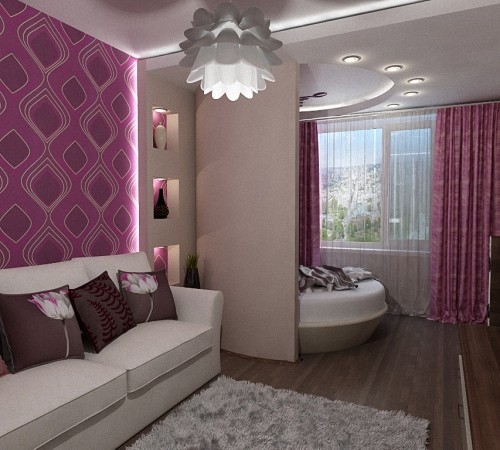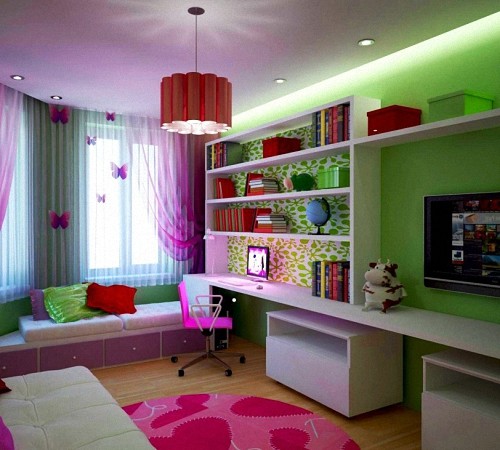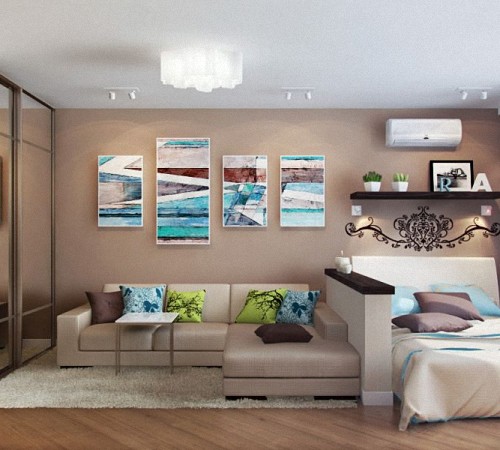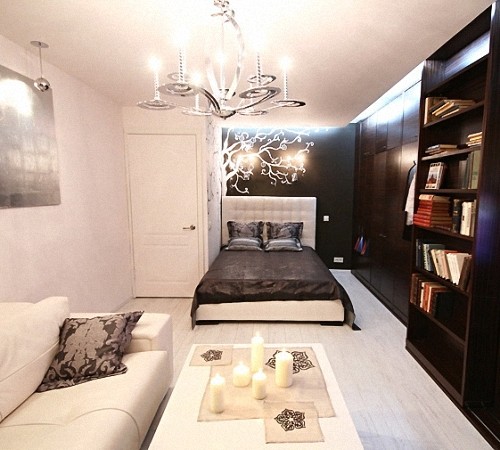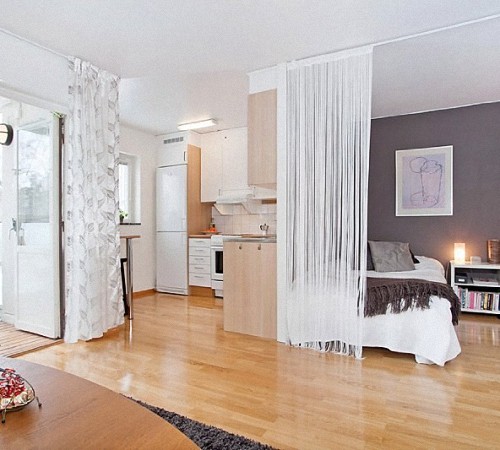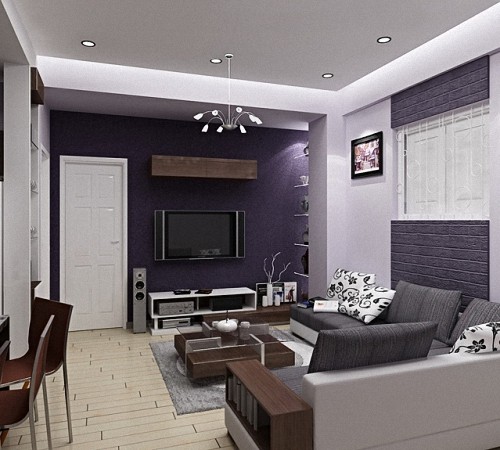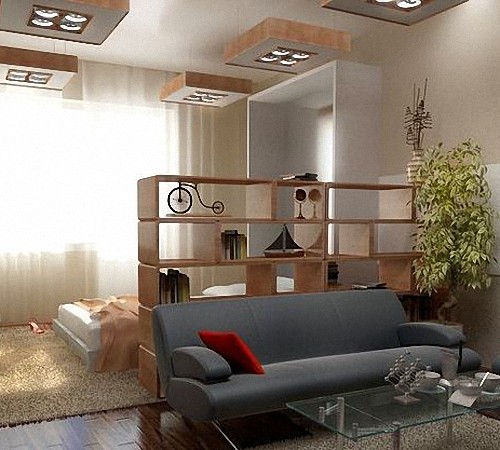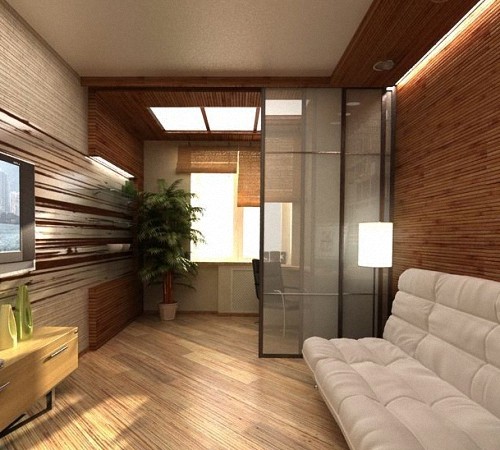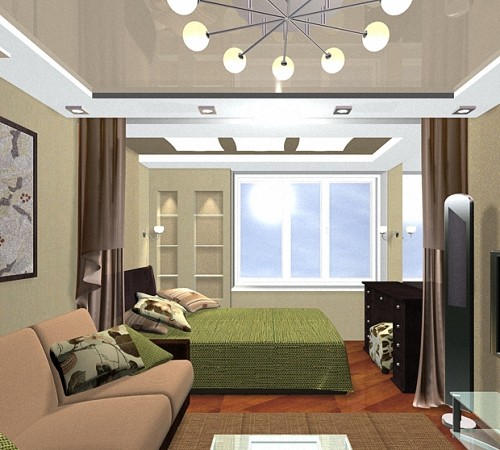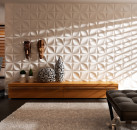The living room is the room where they are going to jointly view television programs communicate with the whole family and receive guests. But if this is a one -room apartment where there is only a hall, then one option remains - a living room combined with a bedroom. A similar case when each family member does not have its own room, and you have to combine personal space with the guest zone. However, the correct organization of space will help not only combine them, but also competently distinguish them.
Content
Options for distinguishing space in the living room
Modern interiors of living rooms combined with a bedroom do not imply a pile of large number of corps furniture as partitions. This is a morally obsolete method, especially since the cabinets overlap the light and take a considerable part of the useful area. The most progressive method is considered the zoning method, which is successfully used in a spacious house without walls, and in a small -sized “hotel”, and in a small dorm room.
The main reasons for the department in the living room of the bedroom:
- the eldest child does not have a separate room for study and rest;
- the whole family has the only dwelling;
- for a small child, you need to organize a separate place for sleeping;
- the need for a married couple to divide the living room into 2 independent units so that there is an opportunity to fully rest while the other is awake;
- parents or children-studants often come, for whom it is important to have a secluded personal space;
- the lifestyle or business involves a frequent reception of guests at home in the apartment of small area (tutoring, coaching, small trade at home).
It is important to organize the design of a large living room or a spell hall most thoughtfully in order to avoid illiterate redevelopment or excessive pile. The redevelopment is much more expensive than crossing space, and costs are not always justified. The general rule - there should not be many furniture, and all of it should be as functional and compact as possible.
The main options for distinguishing the bedroom and guest zone using:
- decorative curtains and curtains;
- glass partitions;
- mobile screens;
- stationary partitions;
- light racks instead of cabinet furniture;
- zoning with upholstered furniture.
Most often they combine several methods at the same time, and there is an even more original method - to use transforming and compactly laying furniture. If in a one -room apartment the main room is equipped as a large bedroom with a guest corner, then by the arrival of guests it is supplemented by an inflatable sofa and other landing places. As, for example, a combined living room and bedroom - a photo.
One room can combine several functions at the same time, regardless of its area, functional zoning remains the best way to situation. This makes the living room the most comfortable, because it is convenient that every family member can do their own business in the personal corner without interfering with others. The easiest way, when there are headphones, one can watch a TV in the guest zone, the other to relax in a fenced bedroom “behind the scenes”, the third dinner in the dining room and communicate with friends in social networks, and the fourth to engage in the computer. In this case, no one will interfere with anyone, and everything necessary for everyone remains at the distance of an outstretched hand.
Where to start zoning the living room combined with the bedroom?
Do not rush to drag the furniture in separate corners or put across, it is better to try to divide your room first on paper, determining the exact place and limits of functional areas. Such a sketch can be drawn on paper, where the dimensions of existing furniture are marked, perhaps something will want to replace or add a new one.
It is best to reconsider at least 3 options, taking into account where the windows and doors are located, the television antenna and the Internet cable are connected, there are sockets and switches. In extreme cases, the extension cable can be thrown from the outlet, and the cable can be increased so that the zoning is most comfortable. Remember that the best option is the one that all family members will like. Only after a joint discussion of all advantages can you begin to implement it.
The most important thing in distinction is to determine which area will be at the window, since each option has advantages and disadvantages.
1. If the bedroom is next to the windows, then with the help of heavy curtains in the daytime you can additionally darken the recreation area, especially when people work and rest on shifts. The disadvantage is that it will become dark in the entire living room at the same time, and when zoning, additional lighting will be required. But if the family gathers at home only in the evening, then this will not complicate anyone.
2. The guest zone by the window is a convenient and comfortable option for guests and a family resting on the TV, but you will have to walk and flicker past the eye of a resting in the bedroom zone. It is advisable to put a partition at the wear of the bed or separate with a light curtain on a ceiling cornice. The most inconvenient when the bed stands right at the entrance to the living room, an apartment, so it is important to think about how to combine the living room and the bedroom opposite the door.
Sometimes it makes sense to make a low stationary partition according to the type of bayer. That is, it can be a wall not higher than 1 meter high, and the rest of the wall is a large window, plus a full -fledged door. This will increase noise insulation, but this method of separating the living room and the bedroom is quite rare. Laste can be made from drywall, and noise insulation can be additionally increased using thick sheets of foam. Pentone does not require additional seal.
In order to completely separate for a while, such a half-wall can be equipped with blinds or a curtain controlled remotely on a movable cornice. Such designs are known for small weight and reliability, and the demarcation method is suitable in the living room at least 6 meters in length. If the door is not planned, then the passage can be decorated in the form of an arch with a hanging thread curtain.
One of the most modern ways to combine the guest zone and bedroom in the common room is zoning using the podium and curtains on the ceiling cornice. The podium itself can be equipped with drawers for storing things. Zoning can be temporary when light furniture is quickly crossed out, and the sofa moves on wheels. This is convenient before the arrival of the guests, and if the back of the sofa is quite high, it can become an impromptu battery, behind which there is a bed or other sleeping place.
Tip: It is recommended to organize a sleep zone in the most separate and well -ventilated corner of the room. Instead of the wall between the two zones of the living room, you can use a high aquarium, an airborne panel, a storyteller with indoor flowers, a stained glass partition, light racks for books and souvenirs and other decorative elements. Cabinet furniture can be used partially in zoning - one cabinet is put on to one of the walls so that there are enough opportunities for natural light. However, stationary glass partitions and transparent curtains on the ceiling cornice today remain the best zoning method, along with the organization of the guest zone using upholstered furniture.
Solutions for small rooms and apartments of small area
In each apartment, it is easy to visually determine the functionality of the premises, but with a lack of living space, you have to organize space in one room in a special way to divide the places for:
- reception of guests and joint communication;
- sleep and rest;
- food intake;
- study and work at a computer or desk;
- wardrobe;
- games of children.
In a limited space, this problem is very relevant, especially in young families using a minimum of useful area. If the room and apartment are removable or temporarily used, then stationary partitions are not used, and the distinction and zoning of the room is carried out by improvised methods.
Often, 2-3 functional zones make sense to combine into one, for example, in the guest zone the family dines, if there is no other place, but there is where to prepare (hostel conditions). The bedrooms are successfully combined with the children's room, and at night the child is laid on the couch, and spouses occupy the bed. It is important that all family members are comfortable, and everyone had their own personal space.
In a small room, full -fledged functional zones are difficult to create with a minimum of furniture. But you can use folding furniture or use the back partitions of the sofa and cabinets, putting them close to each other. If there is a need to use a curtain to distinguish between space in a small room, then a light ceiling cornice will be the most optimal.
Tip: using curtains and hull furniture as partitions between functional zones, do not forget about additional lighting. It is especially important if there is an additional load on vision - during work and study for textbooks or computer. Whatever the design of the living room, combined with the bedroom, is important to remember the sufficient lighting of each functional zone.
Methods of zoning the living room combined with the bedroom
Interior design experts offer to combine different methods of zoning, organization and distinction between the space of the living room.
1. Zoning using finishing materials. The essence of the method is to visually distinguish between the bedroom place and the guest zone in a single space. Particular materials are used that differ in color and texture, while the curtains, partitions and shelves go into the background, performing a secondary function. For example, in the living room and bedrooms, rugs of different texture are used, the type of wallpaper or plaster is combined on the walls, and a two -level ceiling with soft diode backlight is mounted on the ceiling in the bedroom zone.
2. Zoning using partitions - stationary and sliding. Light walls made of plastic, glass and stained -glass windows perfectly distinguish the living space into functional areas and additionally decorate the living room. Today, the brand is glass partitions that can rise a continuous canvas from ceiling to floor or mount only on part of the wall. Do not worry about their fragility, partitions are made from a particularly durable hardened glass:
- matte and transparent;
- corrugated and sandblasting;
- color and patterned.
3. Zoning using furniture successfully uses bilateral light racks instead of heavy cabinets. This is one of the progressive and practical zoning methods - it is very convenient when the required items can be taken on both sides of the shelves. The same shelves can be additionally equipped with any functional zone, but their contents will emphasize use for the purpose of zoning. Massive furniture is better not to use to avoid piles, and the sofas and chairs are exhibited by an island around the TV, a plasma panel or fireplace in the guest zone. A small glass table will organically complement the place for communication.
4. Zoning using curtains and curtains is a popular budget option, and the use of non -traditional materials and forms of the curtains themselves will not only divide into functional zones, but emphasize the style of interiors. Roman or Japanese curtains, a draped “marquise” or a light transparent veil are an excellent decoration of any room. It is important to choose the color and texture of the fabric, which will fit into the style of the living room as much as possible. A non -standard option is thread and ribbon curtains or a curtains of small shells, beads, amber, bamboo, thin woods and other original solutions.
Expert advice:
- the deaf wall separating the guest zone and the bedroom occupies part of the useful area, takes part of the lighting and complicates the microcirculation of air, so it is better to abandon this method, with the exception of the need for soundproofing;
- the doorway can be replaced with a sliding screen;
- the plane of the partition is possible as furniture (hanger, shelves, racks);
- competent lighting is not only used for its intended purpose in each functional zone of the living room, but also capable of transforming the room (floor and wall lamps, chandeliers and sconces, point and tape diodes);
- visual distinction using color should combine close shades in the recreation area and reception of guests: purple and lilac, white and gray, beige and brown, blue and blue, emerald and lettuce;
- so that the furniture does not burn out the free space, but serve as an additional demarcation, it is better to use sofas with a high back, wardrobes, light racks and shelves without doors, and corps furniture is compact and low;
- a great option is to combine several methods of zoning and demarcation.
